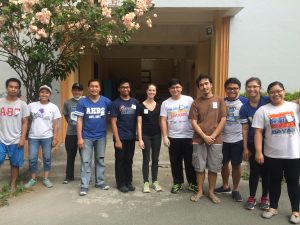By Alicia Blimkie
It’s easy to love the Philippines. The country is a place of contrasts, with a mere handful of blocks separating towering glass skyscrapers from shacks with tin roofs that could fall over with a single gust of wind (and the country gets a lot of typhoons, so fall over they do). But one thing that stays constant is the people. Their friendliness crosses class divides and endures hardships. No matter where I walk, I’m always greeted with a smile and “Morning, po!” This spark in people’s eyes is even more spectacular when you realize the suffering that this country has experienced. Centuries of colonization (first under the Spanish, then the Americans), massive casualties during WWII, then a decade of dictatorship and martial law under the Marcos regime forced the country through seemingly endless suffering, in multiple forms. The true resilience of the Filipino people is demonstrated by the fact that all of this violence culminated in the peaceful EDSA People Power Revolution in 1986, which ushered in a transition to democracy.

But the freedom that was found after the transition is now under threat. I’ve heard people say that the atmosphere today feels like it did in the 1980s, when fundamental freedoms were stamped out. Many journalists and other political activists are afraid to speak out against the government. (If you think the fake news issue was bad during the 2016 U.S. election, you should look at the fake news in the Philippines). Political opposition leaders have been attacked, some having been thrown in jail for yet-unproven drug offenses.
But I’d like to write about one particular event. While my tired body was being carried through the air, across the Pacific to Manila, the Justices of the Supreme Court of the Philippines were busy voting out their Chief Justice. Imagine, for a moment, that the Supreme Court of Canada voted to oust Wagner or dear Bev McLachlin from the court. Yes, this is just as crazy and unfathomable as it sounds. And it was unthinkable for many of the Filipino lawyers I work with, as well.
To put the incident in context, the Philippines has a government and judiciary modeled after the American system, including built-in checks and balances on power. Filipino lawyers and law students look up to their Supreme Court as upholding independence and rule of law as much as we do. This was a shock. Filipino law students are taught that the only way to remove a Chief Justice from office is through impeachment – they would get the question wrong on their exam if they wrote otherwise. Instead, Chief Justice Sereno was removed via a process called quo warranto, which essentially declares that the appointment was never valid in the first place. The court was able to justify its use of quo warranto by interpreting a phrase in the Constitution which states that the Chief Justice may be removed by impeachment to mean that she could also be removed through other means. This diverged from how the provision had previously been interpreted, thus, as some argue, contravening stare decisis.
What are the consequences of this? Chief Justice Sereno had opposed the current government multiple times in her judgments. It was the Solicitor General – representing the government – that submitted the petition for quo warranto. The worry is that the highest court is being influenced by political pressure. In a country where officials are constantly accused of involvement with drug trafficking, and where alleged traffickers are often killed without due process, this is a serious issue. And if government officials can now use quo warranto proceedings to remove members of the judiciary who oppose them then they also have the chance to fill these positions with those who are loyal to the regime. So much for a strong, independent institution.

A loss of judicial independence is not just an academic or legal issue, it has serious human rights implications. One issue is due process. For those officials who can be removed via quo warranto, there is a prescription period of one year. In its reasoning, the Supreme Court stated that this deadline did not apply to the government. But if that is the case, with what other offenses can the government charge people, regardless of prescription? The court that was supposed to protect individual rights could potentially rule in line with its political inclinations now, more than with the law. Freedom of expression may also be negatively impacted. The removal of someone in a high-ranking position who stood up against the government contributes to an atmosphere of fear. If the Chief Justice can be removed by a President who doesn’t like her, what about people with lower profiles whose stories will not end up in the news?

Ultimately, this event made me reflect on the fact that the institutions to which we cling so tightly are largely abstract, and often ephemeral. Even if the buildings and the people working in them are physical, much of an institution’s effectiveness depends on the trust of the public and the willingness of employees to do their work in good faith. These structures are fragile, and what can reduce them to rubble is simply people changing their minds. The question of how to build institutions that will withstand the test of time is a difficult one, but it is highly important, particularly for societies with violent pasts that are rebuilding for a brighter present and future.
